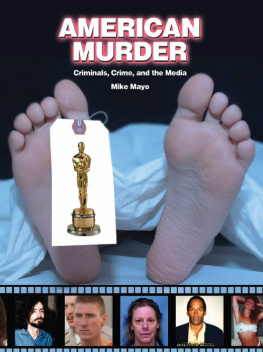100 MOST INFAMOUS
Criminals
JO DURDEN SMITH

2013 by Arcturus Publishing Limited
All rights reserved. No part of this publication may be reproduced, stored in a retrieval system, or transmitted, in any form or by any means electronic, mechanical, photocopying, recording or otherwise, without prior written permission from the publisher.
Arcturus Publishing Limited
26/27 Bickels Yard
151-153 Bermondsey Street
London SE1 3HA
ISBN-13: 978-1-78212-750-5
Contents
International
Sada Abe
W hen a police inspector walked into a Tokyo inn room on the afternoon of May 20th 1936 to check out the identity of the occupant, he didnt expect to find 31-year-old Sada Abe. And even after shed announced who she was, he refused to believe her. Then, though, she took out of her bodice a paper parcel and unfolded it and the evidence was unmistakable. For it contained the severed genitals of her dead lover, Kichizo Ishida.
The naked body of restaurant-owner Ishida had been found by a chambermaid two days before in a room in the equivalent of a modern love-hotel. Carved onto his thigh and written in blood on a bedsheet were the characters Sada, Kichi Futari-kiri (Sada and Kichi, inseparable forever). The word Sada had been written on his left arm. His penis and testicles had been cut off.
Sada was a waitress at Ishidas restaurant; and the police soon put out a warrant for her and circulated her photograph to the press, which ran the details of the crime as frontpage news. When she was finally arrested having written two letters of farewell, as well as a long emotional message to her dead lover, as it turned out the newspapers printed special editions. Sada was suddenly the hottest story in the entire country.
Sada Abe was the last child of a prosperous mat-maker in Kanda. But she was an incorrigible and promiscuous teenager, and at 18 her father sold her to a brothel in Yokohama as a geisha. She worked in the sex business, one way and another, through her twenties; and ended up in Tokyo as the kept woman of a rich middle-aged man. It was then perhaps out of boredom, perhaps out of a need to earn extra cash that she took a job as a waitress in Ishidas restaurant.
Ishida was married, with children, but he was also an inveterate womanizer; and it wasnt long before the two of them were secretly meeting for increasingly frenzied sex-sessions anywhere they could. Sada was insatiable doctors later suggested she must have had a medical condition but in Ishida shed met her match. They began to push at the boundaries, obsessively searching out new ways to pleasure each other. She would throttle him with a sash cord to just this side of insensibility, so that a new flow of blood would travel to his penis, ballooning it and producing in both of them staggering, heart-stopping orgasms. Finally, they went too far.
Its possible that a sedative Sada had bought for Ishida whod been complaining of insomnia had weakened his resistance. But Sada, in interviews with the police, claimed that shed meant to kill him. She said:
I loved him so much, I wanted him all to myself I knew that if I killed him no other woman could ever touch him again, so I killed him.
About the cutting off of his genitals, she added:
[They] belonged to someone I loved. Everything of Ishidas had become mine.
Sada who by then had spawned a new Japanese word, Sada-ism was sentenced to six years imprisonment, but was released under an amnesty in 1941. She moved away from Tokyo under an assumed name, and got married. Then, in 1947, she was rediscovered by a journalist, and the whole story was retold in garish detail in a best-seller, The Sex Confessions of Sada. In a subsequent magazine interview with a well-known author, Sada said that she had only ever loved one man, Kichizo Ishida. The author later described what shed done as:
total love for her to cut off his member as a keepsake was the ultimate feminine act.
The last time Ishidas genitals were seen was at a post-war department-store exhibition sponsored by among others the Department of Health and Welfare. Since then a full-scale biography of Sada has appeared, as well as several films about her and Ishidas liaison: among them the erotic masterpiece of Nagisa Oshima, In the Realm of the Senses.
Idi Amin
W hen Milton Obote in 1962 became the first prime minister of newly-independent Uganda, he had to forge his countrys forty independent tribes into a new national unity. This required finesse, but also, on occasion, brutality; and for brutality he increasingly relied on the deputy-commander of his army, a semi-literate ex-heavyweight champion and sergeant in the Kings African Rifles: Idi Amin.
Amin was a Muslim from a minority tribe, an outsider with no loyalties to any particular power bloc nor, indeed, to Obote. For in 1971, he took power himself in an army-led coup; and almost immediately started killing the officers who had helped him. Gathered together in groups under various pretexts, they were variously bayonetted to death, crushed by tanks or blown up by grenades thrown into rooms locked from the outside. The severed head of the murdered chief-of-staff found a home in Amins freezer. When two Americans, one a journalist, got wind of this wholesale slaughter, they were simply disposed of.

Idi Amin took power in 1971
Amin was soon demanding massive injections of cash from Britain and Israel. He got none; and within a year, with all its stocks of dollars and pounds reserved for Amins own use, Uganda was bankrupt. Only money from Colonel Gadaffi in Libya kept it afloat and this meant having to toe Libyas political line. Amin, then, began a prolonged tirade against the state of Israel. Israeli engineers working on construction projects were thrown out of the country; and an office of the Palestine Liberation Organization was opened in Kampala instead. Amin, warming to his task, started to express his profound admiration for Adolf Hitler; and even set up a domestic version of Hitlers Gestapo, the State Research Bureau, filled with hundreds of highly-paid killers.
Gadaffis money, though, was not enough to guarantee the loyalty of all those Amin had to buy. So in August 1972, he announced that hed had a visit from God; and God had told him that Ugandas Asian population, most of them professionals, merchants and shopkeepers, were at the root of the countrys economic troubles. He gave them ninety days to leave the country; and when they fled, he handed over their businesses and shops to his cronies who inevitably ran them into the ground. Once more they had to be paid; and the only commodity Amin had left to deal in was the lives of his fellow-Ugandans.

Amin was eventually exiled to Saudi Arabia
Ugandans have a profound respect for the bodies of their dead and this is what Amin began to trade on. His State Research Bureau were licensed to kill anyone they chose, and then to offer their services to their victims families as body-finders for as large a fee as they could charge. The families were told that their sons or husbands had been arrested and were feared dead. They were then led, sometimes hundreds of them a night, to the dumping-grounds, in a forest outside Kampala. (Unclaimed and therefore profitless bodies were simply dumped into Lake Victoria.) When the French Embassy complained about the constant gunfire coming from the Research Bureaus headquarters, Amin and his Bureau chief invented a new variation of the production line: one kidnapped prisoner was offered his life in return for bludgeoning another to death with a sledgehammer. Then he took the second prisoners place
Next page














